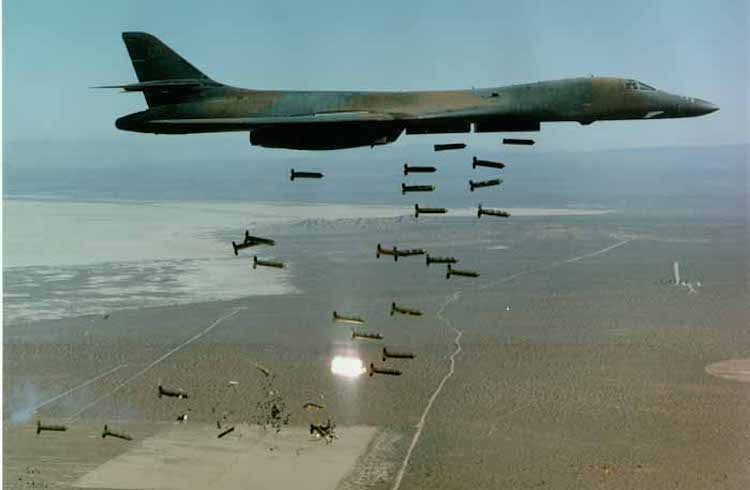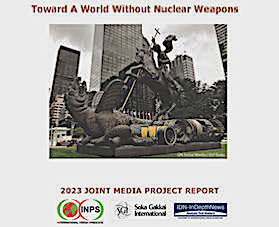By J C Suresh
TORONTO | WASHINGTON DC 6 July 2023 (IDN) — President Biden is "under steady pressure from Ukraine's President Volodymyr Zelensky" to transfer banned cluster munitions, arguing that the munitions were "the best way to kill Russians who are dug into trenches and blocking Ukraine’s counteroffensive", reports New York Times.
If he decides to give, the US will be violating the Convention on Cluster Munitions, warns the independent, nongovernmental Arms Control Association (ACA).
Considering that the limited military value and the indiscriminate impacts of these weapons led the majority of the world’s countries—123 nations have joined—to negotiated the 2008 Convention, which entered into force in 2010. It prohibits states parties from developing, producing, acquiring, using, transferring, or stockpiling cluster munitions. The United States, Ukraine, and Russia are not parties to the treaty, but twenty-three NATO members are.
Cluster munitions are designed to disperse or release explosive submunitions, each of which weighs less than 20 kilograms, and includes those explosive submunitions.
The US stockpile includes dual-purpose improved conventional munitions (DPICMs), surface-to-surface warheads, and other types of older cluster munitions. Given that cluster munitions disperse hundreds or even thousands of tiny but deadly bomblets, their use produces significant quantities of unexploded submunitions that can maim, injure, or kill civilians and friendly forces during, and long after, a conflict.
"Some types of lethal US and European military assistance to Ukraine, including cluster munitions, would be escalatory, counterproductive, and only further increase the dangers to civilians caught in combat zones and those who will, someday, return to their cities, towns, and farms," said Arms Control Association's Executive Director Daryl G. Kimball.
But some US officials claim that these weapons 'would be useful' against mass formations of troops and armor or broad targets, such as airfields, and that they would allow Ukraine to concentrate their use of unitary warheads against higher-value Russian targets.
The reality is more complicated, explains the ACA. Cluster munitions will not differentiate a Ukrainian soldier from a Russian one. The effectiveness of cluster munitions is significantly oversold and the impact on noncombatants is widely acknowledged, but too often overlooked.
The limited military utility and the substantial humanitarian dangers of cluster munitions are among the key reasons why the Defense Department halted using them in Afghanistan in 2002 and Iraq in 2003, and has chosen to invest in alternative munitions.
It is why, in 2008, former Secretary of Defense Robert Gates issued an order to phase out by 2018 cluster munitions with an unexploded ordnance rate of greater than one percent, and it is why, in 2011, the Obama administration affirmed this policy. It is why Congress, in 2018, enacted a series of export restrictions on cluster munitions with a failure rate in excess of one percent.
The Pentagon has, unfortunately, dragged its feet and in 2017, the Trump administration announced the 2018 deadline for phasing out non-compliant cluster munitions would not be met. No new deadline for meeting that goal was set by the Trump administration or the Biden administration.
The impetus to help supply Ukraine with the right kind of weaponry to defend its territory against Russian attacks and occupation is understandable, states the ACA. But cluster munitions are not the "winning weapon" in Ukraine's fight for its future, and the success of its ongoing counteroffensive does not hinge on the delivery of any one particular type of weapon.
Currently, Washington is providing Ukraine with other munitions that are important for its military effort to repel Russia’s forces, including regular 155-millimeter unitary munitions and a new type of 155-mm millimeter artillery shell that can hit targets with greater precision.
Instead of transferring controversial cluster munitions and straining alliance solidarity, Washington and its allies should focus more energy on creative ways to provide Ukraine with the precision-guided munitions and the artillery shells it needs to repel Russian aggression.
It is also clear that cluster munitions produce significant quantities of unexploded submunitions that can maim, injure, or kill civilians and friendly forces during, and long after, a conflict. Human Rights Watch has issued numerous reports detailing civilian harm and suffering from US-made cluster munitions used in countries such as Afghanistan, Iraq, Serbia, and Yemen.
As President Biden noted on the one-year anniversary of Russia’s brutal and unprovoked invasion of Ukraine, "The decisions we make over the next five years are going to determine and shape our lives for decades to come… a choice between chaos and stability."
Rather than add to the chaos and side-step the rules of the global system, "President Biden should make it clear that cluster munitions need not and should not be part of the conflict in Ukraine, or in any war", maintains the Arms Control Association. [IDN-InDepthNews]
Image: USAF B-1 Bomber dropping 30 CBUs (Cluster bombs). WikImedia Commons.













